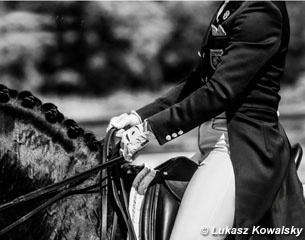
So much of dressage discussion revolves around where the horse's head should be, or what your legs should be doing, or what how you carry and use your hands. I find it interesting considering that the majority of the dressage aids that we give should come from the seat. With this in mind I have started a new chapter in training where I quite simply go out, begin the lesson, and think only on what my seat and Batialo’s back end is doing. It’s incredible how much difference this makes to the overall outcome of the lesson.
If you concentrate solely on your seat and the straightness and engagement of the horse, it’s sounds sort of poetic, but the rest just falls into place. So many riders force the horses head down and then begin. That’s like doing the splits before the warm-up. The hors'es ability to achieve self carriage comes from the back, so why then do so many of use focus on the front?
I used to begin and worry that Batialo wasn’t stretching into the contact, or that he wasn’t round enough, or that his neck wasn’t supple enough and spend the first 20 minutes working on these things, when all the while the big picture was going out the window. Now I go out and I let him out in front. I let him find the spot that he finds comfortable and I work on my seat, on loosening my legs, on where his weight is going, on whether his hind leg is stepping under his centre. I work on bending, yes, but I work on bending that comes form the back and curves through the horse's body, not on bending by pulling the horses head to one side.
If you concentrate solely on the seat you will begin to notice so many patterns that appear that we assume are our horse, when in actual fact it’s almost certainly something we are telling him without us realising. To explain, think about the half half. The half halt is an aid we give by breathing into our back and making ourselves wider in the saddle, an aid that tells the horse to slow down and to rebalance. The half halt, however, is very similar in feeling to when you have a tight back and hip.
I went out today and I am having a really bad back day. My back is stuck and my hip is tight. I started the lesson and Batialo was feeling extremely constipated. The old me would have said, “oh he is being lazy and he is behind my leg”. Focusing on just my seat I knew immediately that because of my tension I was giving him the aid to half halt constantly. He was confused as to why I was telling him to go more forward with my legs. I had to go back to walk, where I could relax my back and work just on simple transitions, letting Batialo know that he was right, it was me, and just working on lateral exercises at the walk to get him supple, while not trying to trot off with my back in tension.
We can come out and the horse isn’t listening to our seat, but that doesn’t mean we just go "oh well i’ll hold with the reins." No! This means that we have to tune the horse back up. We go to walk and ask for halt with our seat. The horse walks off so we give a check on both reins and he says “ah right that’s what that meant”. And we continue.
If it’s one thing that a rider must always remember is that you can’t just keep on doing B if A is a big muddle, and this applies to everything: from trot transitions, to flying changes, to the dressage seat, and everything in between.
by Sarah Warne - Photo © Lukasz Kowalski